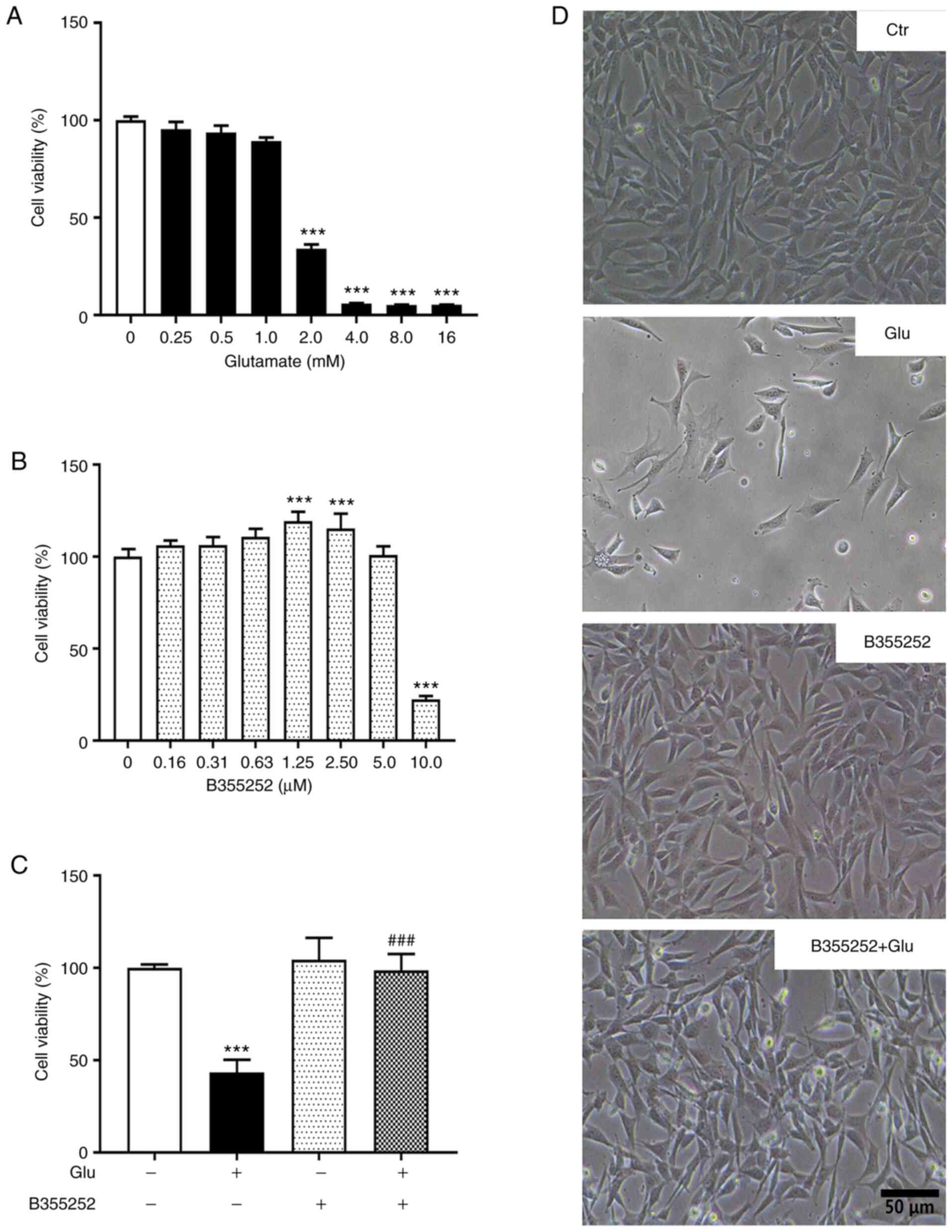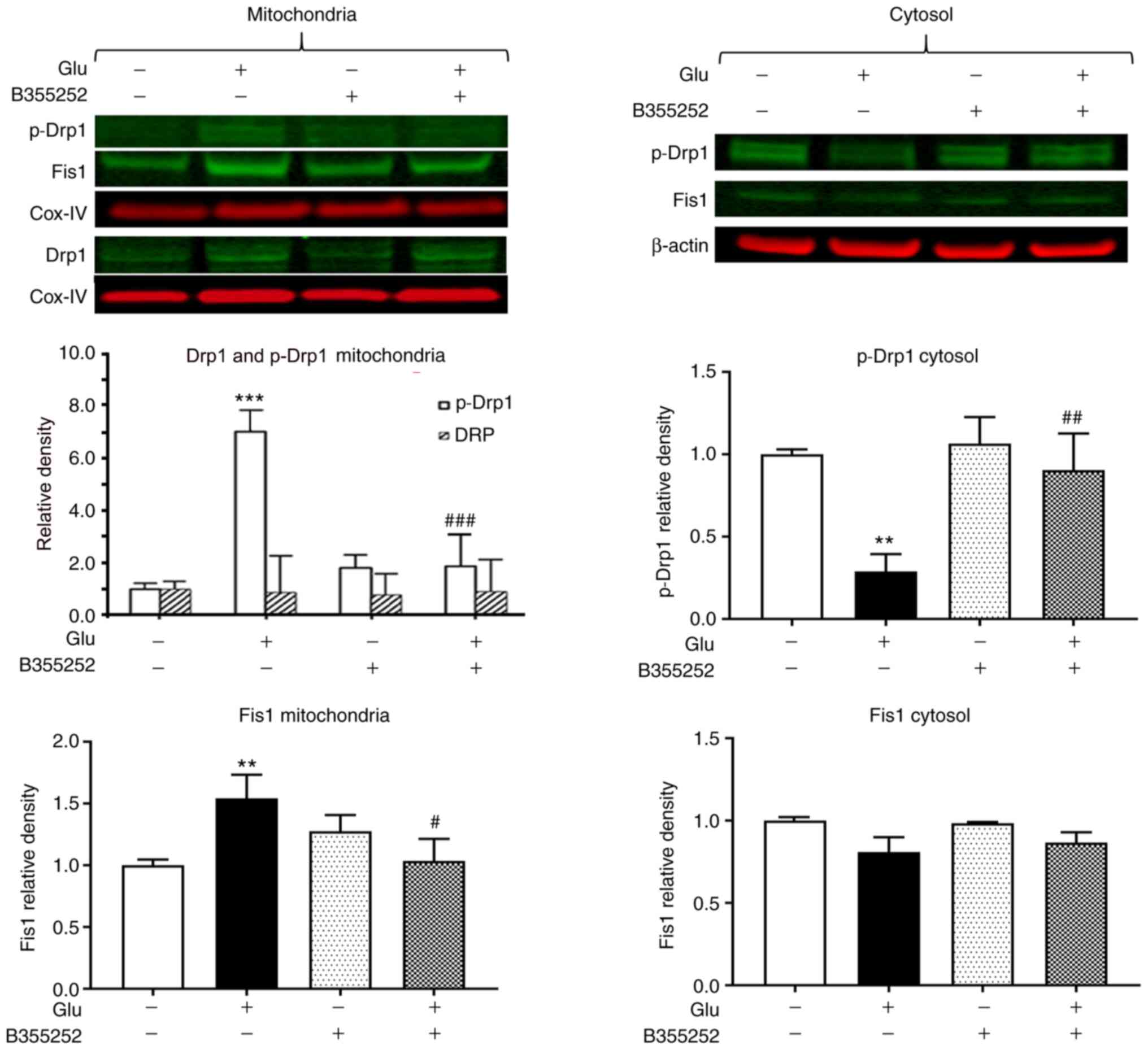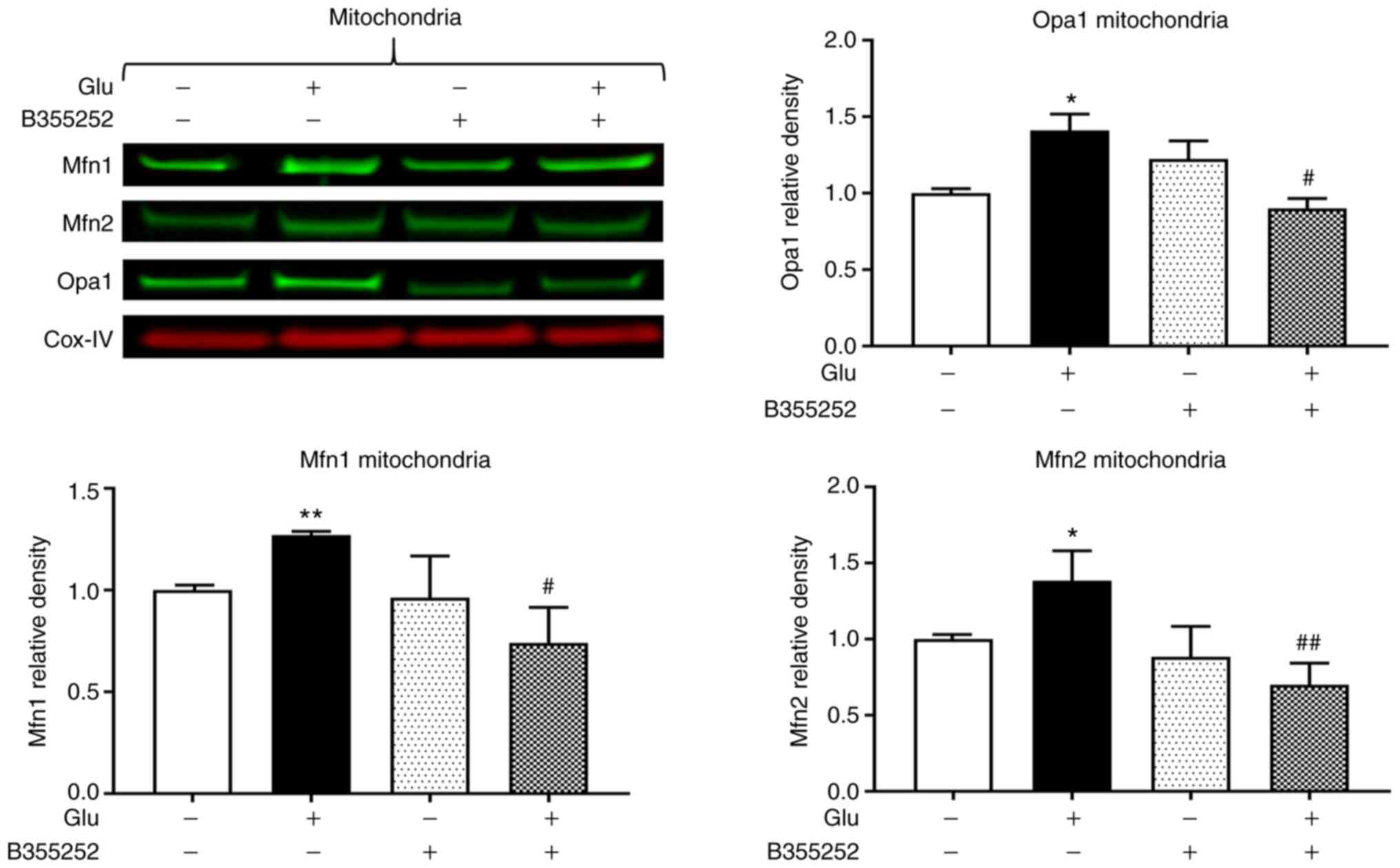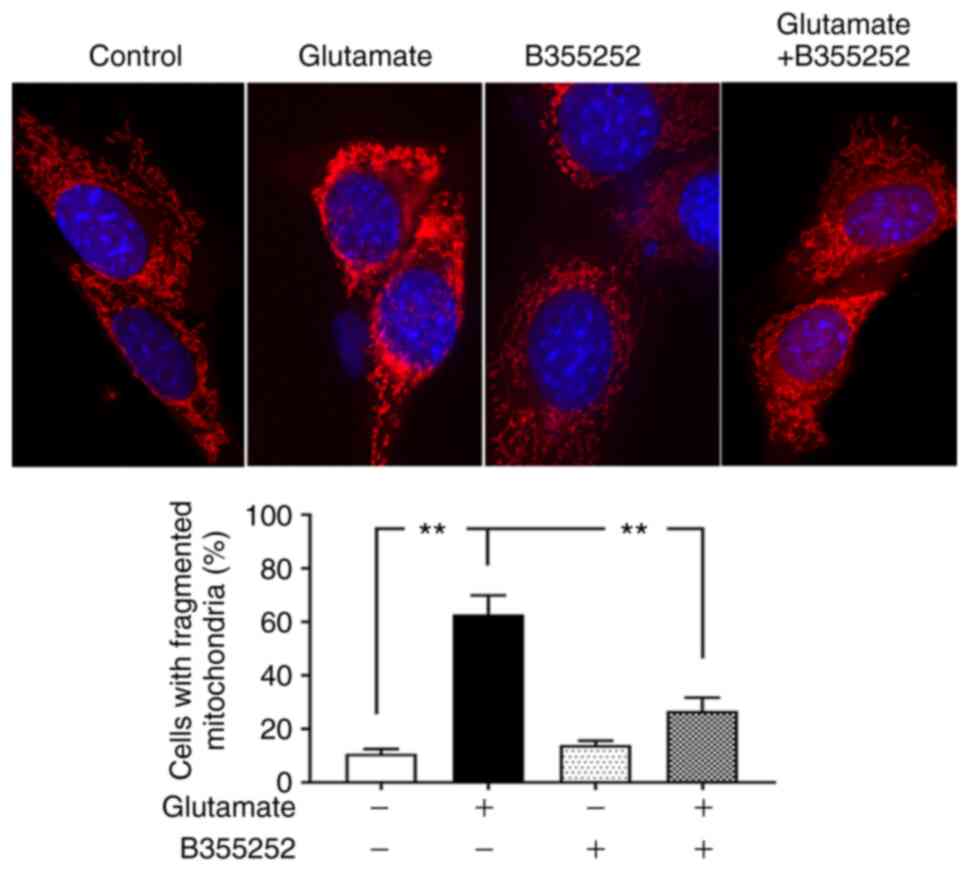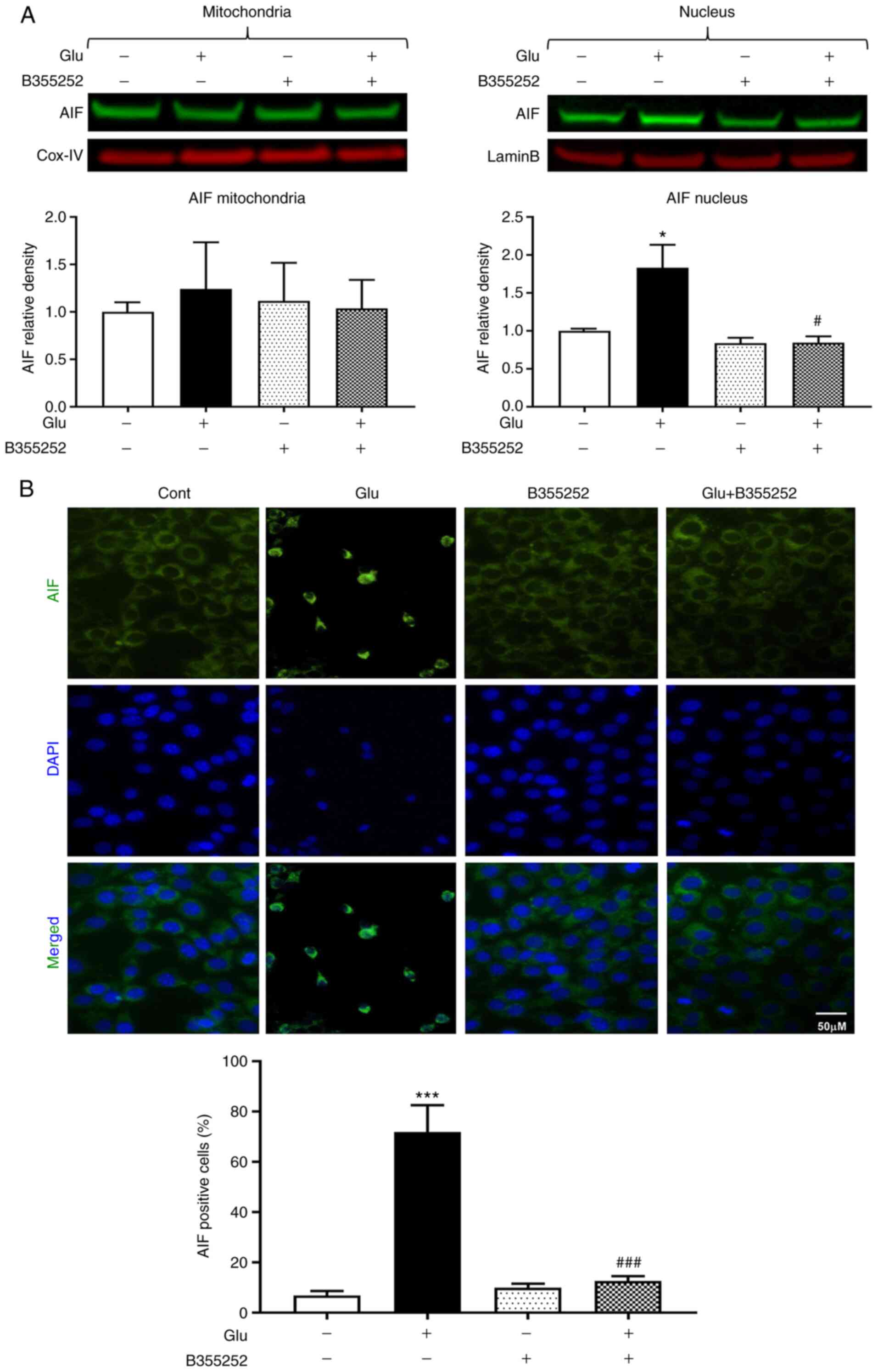|
1
|
Fernandes D and Carvalho AL: Mechanisms of
homeostatic plasticity in the excitatory synapse. J Neurochem.
139:973–996. 2016.PubMed/NCBI View Article : Google Scholar
|
|
2
|
Dzubay JA and Jahr CE: The concentration
of synaptically released glutamate outside of the climbing
fiber-Purkinje cell synaptic cleft. J Neurosci. 19:5265–5274.
1999.PubMed/NCBI View Article : Google Scholar
|
|
3
|
Choi DW: Glutamate neurotoxicity and
diseases of the nervous system. Neuron. 1:623–634. 1988.PubMed/NCBI View Article : Google Scholar
|
|
4
|
Lau A and Tymianski M: Glutamate
receptors, neurotoxicity and neurodegeneration. Pflugers Arch.
460:525–542. 2010.PubMed/NCBI View Article : Google Scholar
|
|
5
|
Lewerenz J and Maher P: Chronic glutamate
toxicity in neurodegenerative diseases-what is the evidence? Front
Neurosci. 9(469)2015.PubMed/NCBI View Article : Google Scholar
|
|
6
|
Mehta A, Prabhakar M, Kumar P, Deshmukh R
and Sharma PL: Excitotoxicity: Bridge to various triggers in
neurodegenerative disorders. Eur J Pharmacol. 698:6–18.
2013.PubMed/NCBI View Article : Google Scholar
|
|
7
|
Jezek J, Cooper KF and Strich R: Reactive
oxygen species and mitochondrial dynamics: The Yin and Yang of
mitochondrial dysfunction and cancer progression. Antioxidants
(Basel). 7(13)2018.PubMed/NCBI View Article : Google Scholar
|
|
8
|
Bock FJ and Tait SWG: Mitochondria as
multifaceted regulators of cell death. Nat Rev Mol Cell Biol.
21:85–100. 2020.PubMed/NCBI View Article : Google Scholar
|
|
9
|
Vakifahmetoglu-Norberg H, Ouchida AT and
Norberg E: The role of mitochondria in metabolism and cell death.
Biochem Biophys Res Commun. 482:426–431. 2017.PubMed/NCBI View Article : Google Scholar
|
|
10
|
Archer SL: Mitochondrial
dynamics-mitochondrial fission and fusion in human diseases. N Engl
J Med. 369:2236–2251. 2013.PubMed/NCBI View Article : Google Scholar
|
|
11
|
Westermann B: Mitochondrial fusion and
fission in cell life and death. Nat Rev Mol Cell Biol. 11:872–884.
2010.PubMed/NCBI View
Article : Google Scholar
|
|
12
|
Tandler B, Hoppel CL and Mears JA:
Morphological pathways of mitochondrial division. Antioxidants
(Basel). 7(30)2018.PubMed/NCBI View Article : Google Scholar
|
|
13
|
Song Z, Ghochani M, McCaffery JM, Frey TG
and Chan DC: Mitofusins and OPA1 mediate sequential steps in
mitochondrial membrane fusion. Mol Biol Cell. 20:3525–3532.
2009.PubMed/NCBI View Article : Google Scholar
|
|
14
|
Yeyeodu ST, Witherspoon SM, Gilyazova N
and Ibeanu GC: A rapid, inexpensive high throughput screen method
for neurite outgrowth. Curr Chem Genomics. 4:74–83. 2010.PubMed/NCBI View Article : Google Scholar
|
|
15
|
Williams AL, Dandepally SR, Gilyazova N,
Witherspoon SM and Ibeanu G: Microwave-assisted synthesis of
4-chloro-N-(naphthalen-1-ylmethyl)-5-(3-(piperazin-1-yl)phenoxy)thiophene-2-sulfo
namide (B-355252): A new potentiator of Nerve Growth Factor
(NGF)-induced neurite outgrowth. Tetrahedron. 66:9577–9581.
2010.PubMed/NCBI View Article : Google Scholar
|
|
16
|
Gliyazova NS, Huh EY and Ibeanu GC: A
novel phenoxy thiophene sulphonamide molecule protects against
glutamate evoked oxidative injury in a neuronal cell model. BMC
Neurosci. 14(93)2013.PubMed/NCBI View Article : Google Scholar
|
|
17
|
Gliyazova NS and Ibeanu GC: The chemical
molecule B355252 is neuroprotective in an in vitro model of
Parkinson's disease. Cell Mol Neurobiol. 36:109–122.
2016.PubMed/NCBI View Article : Google Scholar
|
|
18
|
Kumari S, Mehta SL and Li PA: Glutamate
induces mitochondrial dynamic imbalance and autophagy activation:
Preventive effects of selenium. PLoS One. 7(e39382)2012.PubMed/NCBI View Article : Google Scholar
|
|
19
|
Mendelev N, Mehta SL, Witherspoon S, He Q,
Sexton JZ and Li PA: Upregulation of human selenoprotein H in
murine hippocampal neuronal cells promotes mitochondrial biogenesis
and functional performance. Mitochondrion. 11:76–82.
2011.PubMed/NCBI View Article : Google Scholar
|
|
20
|
Sattler R and Tymianski M: Molecular
mechanisms of glutamate receptor-mediated excitotoxic neuronal cell
death. Mol Neurobiol. 24:107–129. 2001.PubMed/NCBI View Article : Google Scholar
|
|
21
|
Stanciu M, Wang Y, Kentor R, Burke N,
Watkins S, Kress G, Reynolds I, Klann E, Angiolieri MR, Johnson JW
and DeFranco DB: Persistent activation of ERK contributes to
glutamate-induced oxidative toxicity in a neuronal cell line and
primary cortical neuron cultures. J Biol Chem. 275:12200–12206.
2000.PubMed/NCBI View Article : Google Scholar
|
|
22
|
Kang Y, Tiziani S, Park G, Kaul M and
Paternostro G: Cellular protection using Flt3 and PI3Kalpha
inhibitors demonstrates multiple mechanisms of oxidative glutamate
toxicity. Nat Commun. 5(3672)2014.PubMed/NCBI View Article : Google Scholar
|
|
23
|
Bavarsad Shahripour R, Harrigan MR and
Alexandrov AV: N-acetylcysteine (NAC) in neurological disorders:
Mechanisms of action and therapeutic opportunities. Brain Behav.
4:108–122. 2014.PubMed/NCBI View
Article : Google Scholar
|
|
24
|
Ma YM, Ibeanu G, Wang LY, Zhang JZ, Chang
Y, Dong JD, Li PA and Jing L: Selenium suppresses glutamate-induced
cell death and prevents mitochondrial morphological dynamic
alterations in hippocampal HT22 neuronal cells. BMC Neurosci.
18(15)2017.PubMed/NCBI View Article : Google Scholar
|
|
25
|
Sanderson TH, Raghunayakula S and Kumar R:
Release of mitochondrial Opa1 following oxidative stress in HT22
cells. Mol Cell Neurosci. 64:116–122. 2015.PubMed/NCBI View Article : Google Scholar
|
|
26
|
Otera H, Wang C, Cleland MM, Setoguchi K,
Yokota S, Youle RJ and Mihara K: Mff is an essential factor for
mitochondrial recruitment of Drp1 during mitochondrial fission in
mammalian cells. J Cell Biol. 91:1141–1158. 2010.PubMed/NCBI View Article : Google Scholar
|
|
27
|
Palmer CS, Osellame LD, Laine D,
Koutsopoulos OS, Frazier AE and Ryan MT: MiD49 and MiD51, new
components of the mitochondrial fission machinery. EMBO Rep.
12:565–573. 2011.PubMed/NCBI View Article : Google Scholar
|
|
28
|
Rosenbloom AB, Lee SH, To M, Lee A, Shin
JY and Bustamante C: Optimized two-color super resolution imaging
of Drp1 during mitochondrial fission with a slow-switching Dronpa
variant. Proc Natl Acad Sci USA. 111:13093–13098. 2014.PubMed/NCBI View Article : Google Scholar
|
|
29
|
Smirnova E, Griparic L, Shurland DL and
van der Bliek AM: Dynamin-related protein Drp1 is required for
mitochondrial division in mammalian cells. Mol Biol Cell.
12:2245–2256. 2001.PubMed/NCBI View Article : Google Scholar
|
|
30
|
Smirnova E, Shurland DL, Ryazantsev SN and
van der Bliek AM: A human dynamin-related protein controls the
distribution of mitochondria. J Cell Biol. 143:351–358.
1998.PubMed/NCBI View Article : Google Scholar
|
|
31
|
Frank S, Gaume B, Bergmann-Leitner ES,
Leitner WW, Robert EG, Catez F, Smith CL and Youle RJ: The role of
dynamin-related protein 1, a mediator of mitochondrial fission, in
apoptosis. Dev Cell. 1:515–525. 2001.PubMed/NCBI View Article : Google Scholar
|
|
32
|
Stojanovski D, Koutsopoulos OS, Okamoto K
and Ryan MT: Levels of human Fis1 at the mitochondrial outer
membrane regulate mitochondrial morphology. J Cell Sci.
117:1201–1210. 2004.PubMed/NCBI View Article : Google Scholar
|
|
33
|
James DI, Parone PA, Mattenberger Y and
Martinou JC: hFis1, a novel component of the mammalian
mitochondrial fission machinery. J Biol Chem. 278:36373–36379.
2003.PubMed/NCBI View Article : Google Scholar
|
|
34
|
Tian Y, Li B, Shi WZ, Chang MZ, Zhang GJ,
Di ZL and Liu Y: Dynamin-related protein 1 inhibitors protect
against ischemic toxicity through attenuating mitochondrial Ca2+
uptake from endoplasmic reticulum store in PC12 cells. Int J Mol
Sci. 15:3172–3185. 2014.PubMed/NCBI View Article : Google Scholar
|
|
35
|
Cribbs JT and Strack S: Reversible
phosphorylation of Drp1 by cyclic AMP-dependent protein kinase and
calcineurin regulates mitochondrial fission and cell death. EMBO
Rep. 8:939–944. 2007.PubMed/NCBI View Article : Google Scholar
|
|
36
|
Chang CR and Blackstone C: Cyclic
AMP-dependent protein kinase phosphorylation of Drp1 regulates its
GTPase activity and mitochondrial morphology. J Biol Chem.
282:21583–21587. 2007.PubMed/NCBI View Article : Google Scholar
|
|
37
|
Taguchi N, Ishihara N, Jofuku A, Oka T and
Mihara K: Mitotic phosphorylation of dynamin-related GTPase Drp1
participates in mitochondrial fission. J Biol Chem.
282:11521–11529. 2007.PubMed/NCBI View Article : Google Scholar
|
|
38
|
Otera H and Mihara K: Molecular mechanisms
and physiologic functions of mitochondrial dynamics. J Biochem.
149:241–251. 2011.PubMed/NCBI View Article : Google Scholar
|
|
39
|
Bartolák-Suki E, Imsirovic J, Nishibori Y,
Krishnan R and Suki B: Regulation of mitochondrial structure and
dynamics by the cytoskeleton and mechanical factors. Int J Mol Sci.
18(1812)2017.PubMed/NCBI View Article : Google Scholar
|
|
40
|
Meeusen S, McCaffery JM and Nunnari J:
Mitochondrial fusion intermediates revealed in vitro. Science.
305:1747–1752. 2004.PubMed/NCBI View Article : Google Scholar
|
|
41
|
Wai T, García-Prieto J, Baker MJ,
Merkwirth C, Benit P, Rustin P, Rupérez FJ, Barbas C, Ibañez B and
Langer T: Imbalanced OPA1 processing and mitochondrial
fragmentation cause heart failure in mice. Science.
350(aad0116)2015.PubMed/NCBI View Article : Google Scholar
|
|
42
|
Bertholet AM, Delerue T, Millet AM, Moulis
MF, David C, Daloyau M, Arnauné-Pelloquin L, Davezac N, Mils V,
Miquel MC, et al: Mitochondrial fusion/fission dynamics in
neurodegeneration and neuronal plasticity. Neurobiol Dis. 90:3–19.
2016.PubMed/NCBI View Article : Google Scholar
|
|
43
|
Kushnareva YE, Gerencser AA, Bossy B, Ju
WK, White AD, Waggoner J, Ellisman MH, Perkins G and Bossy-Wetzel
E: Loss of OPA1 disturbs cellular calcium homeostasis and
sensitizes for excitotoxicity. Cell Death Differ. 20:353–365.
2013.PubMed/NCBI View Article : Google Scholar
|
|
44
|
Nguyen D, Alavi MV, Kim KY, Kang T, Scott
RT, Noh YH, Lindsey JD, Wissinger B, Ellisman MH, Weinreb RN, et
al: A new vicious cycle involving glutamate excitotoxicity,
oxidative stress and mitochondrial dynamics. Cell Death Dis.
2(e240)2011.PubMed/NCBI View Article : Google Scholar
|
|
45
|
Jahani-Asl A, Poilon-Larose K, Xu W,
Maclaurin JG, Park DS, McBride HM and Slack RS: The mitochondrial
inner membrane GTPase, optic atrophy 1 (Opa1), restores
mitochondrial morphology and promotes neuronal survival following
excitotoxicity. J Biol Chem. 286:4772–4782. 2011.PubMed/NCBI View Article : Google Scholar
|
|
46
|
Wang W, Zhang F, Li L, Tang F, Siedlak SL,
Fujioka H, Liu Y, Su B, Pi Y and Wang X: MFN2 couples glutamate
excitotoxicity and mitochondrial dysfunction in motor neurons. J
Biol Chem. 290:168–182. 2015.PubMed/NCBI View Article : Google Scholar
|
|
47
|
Wang X, Su B, Siedlak SL, Moreira PI,
Fujioka H, Wang Y, Casadesus G and Zhu X: Amyloid-beta
overproduction causes abnormal mitochondrial dynamics via
differential modulation of mitochondrial fission/fusion proteins.
Proc Natl Acad Sci USA. 105:19318–19323. 2008.PubMed/NCBI View Article : Google Scholar
|
|
48
|
Jahani-Asl A, Vheung EC, Neuspiel M,
MacLaurin JG, Fortin A, Park DS, McBride HM and Slack RS: Mitofusin
2 protects cerebellar granule neurons against injury-induced cell
death. J Biol Chem. 282:23788–23798. 2007.PubMed/NCBI View Article : Google Scholar
|
|
49
|
Neuspiel M, Zunino R, Gangaraju S,
Rippstein P and McBride H: Activated mitofusin 2 signals
mitochondrial fusion, interferes with Bax activation, and reduces
susceptibility to radical induced depolarization. J Biol Chem.
280:25060–25070. 2005.PubMed/NCBI View Article : Google Scholar
|
|
50
|
Ju Wk, Lindsey JD, Angert M, Patel A and
Weinreb RN: Glutamate receptor activation triggers OPA1 release and
induces apoptotic cell death in ischemic rat retina. Mol Vis.
14:2629–2638. 2008.PubMed/NCBI
|
|
51
|
Halestrap AP: What is the mitochondrial
permeability transition pore? J Mol Cell Cardiol. 46:821–831.
2009.PubMed/NCBI View Article : Google Scholar
|
|
52
|
Sevrioukova IF: Apoptosis-inducing factor:
Structure, function, and redox regulation. Antioxid Redox Signal.
14:2545–2579. 2011.PubMed/NCBI View Article : Google Scholar
|
|
53
|
Jantas D, Greda A, Leskiewicz M, Grygier
B, Pilc A and Lason W: Neuroprotective effects of mGluR II and III
activators against staurosporine- and doxorubicin-induced cellular
injury in SH-SY5Y cells: New evidence for a mechanism involving
inhibition of AIF translocation. Neurochem Int. 88:124–137.
2015.PubMed/NCBI View Article : Google Scholar
|
|
54
|
Piao CS, Loane DJ, Stoica BA, Li S,
Hanscom M, Cabatbat R, Blomgren K and Faden AI: Combined inhibition
of cell death induced by apoptosis inducing factor and caspases
provides additive neuroprotection in experimental traumatic brain
injury. Neurobiol Dis. 46:745–758. 2012.PubMed/NCBI View Article : Google Scholar
|
|
55
|
Tobaben S, Grohm J, Seiler A, Conrad M,
Plesnila N and Culmsee C: Bid-mediated mitochondrial damage is a
key mechanism in glutamate-induced oxidative stress and
AIF-dependent cell death in immortalized HT-22 hippocampal neurons.
Cell Death Differ. 18:282–292. 2011.PubMed/NCBI View Article : Google Scholar
|















